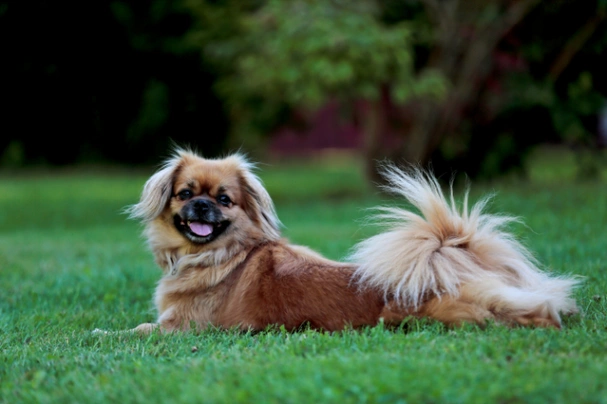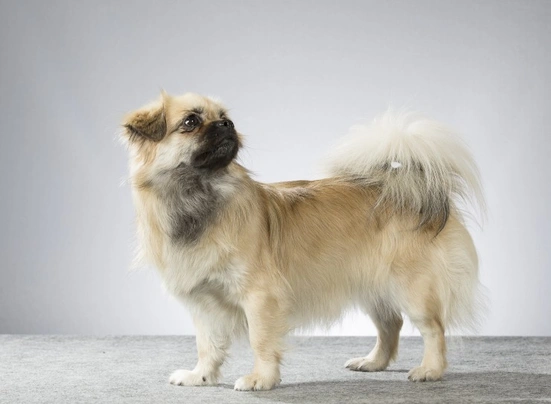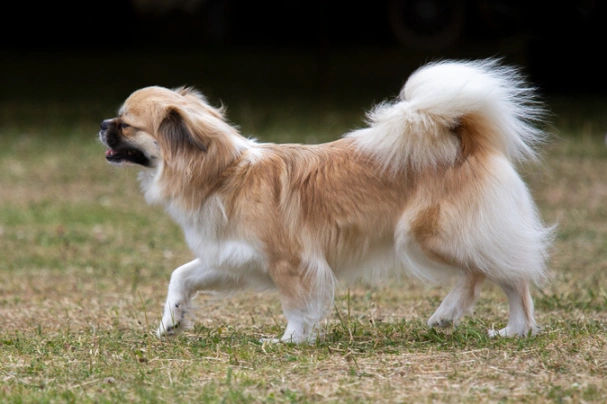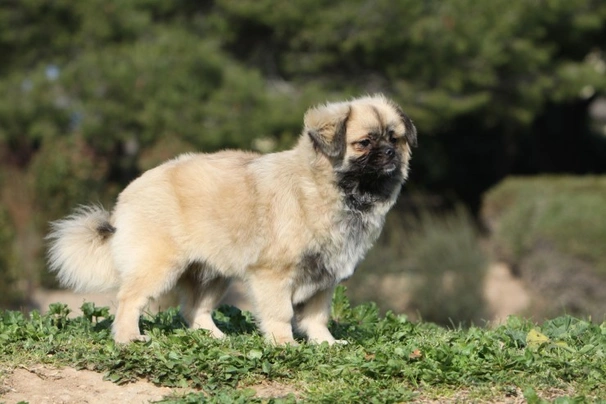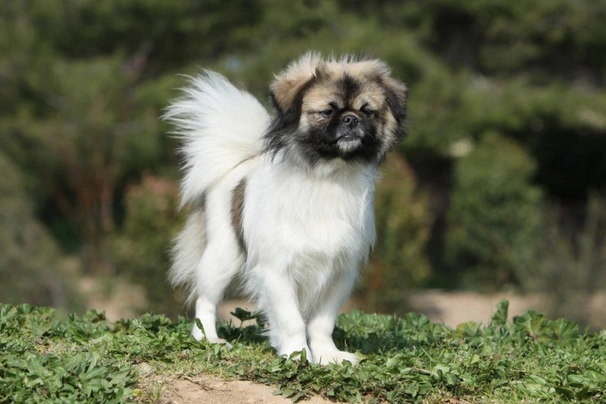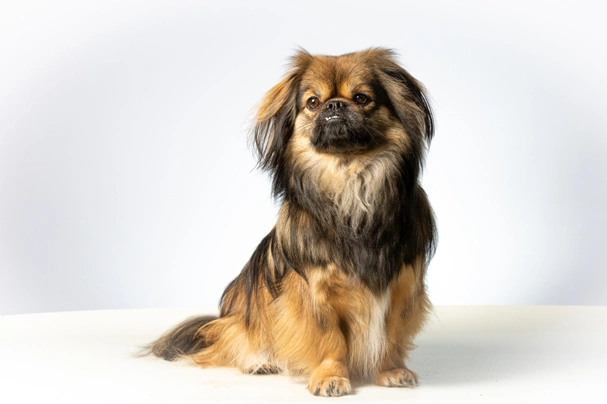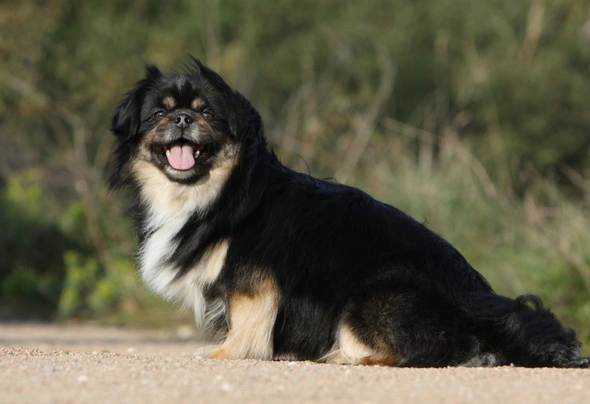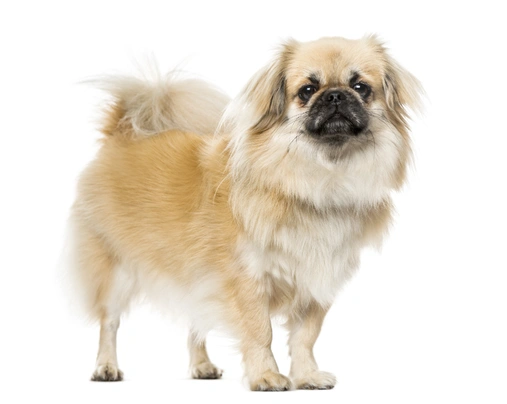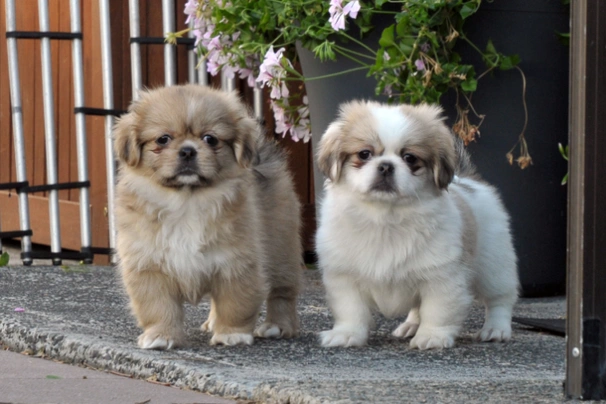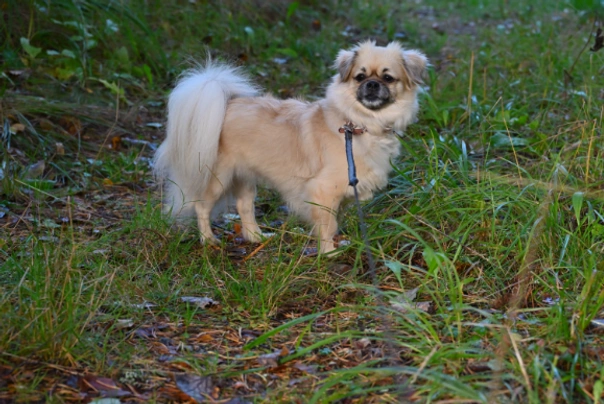Tibetan Spaniel
Pros
Cons
Introduction of the Tibetan Spaniel
Tibetan Spaniels are charming dogs that are affectionately known as Tibbies. They hail from the high mountain regions of the Himalayas where they were originally bred by monks and since they were first introduced to the UK they have become a popular choice as companions and family pets thanks to their sweet personalities and adorable looks.
Today Tibetan Spaniels are popular not only here in the UK but in many other countries of the world and as always they are a huge hit when exhibited at dog shows too. Tibbies are renowned for being good watchdogs that like to position themselves on high vantage points so they can better see what is going on in their environment.
History of the Tibetan Spaniel
Tibetan Spaniels are thought to be one of the most ancient breeds to come out of Tibet where they were revered by monks who lived in monasteries in the high remote mountain regions of the Himalayas. They were highly prized watch dogs thanks to their love of sitting up high so they could watch over everything that was happening far below them. However these little dogs were also prized by the monks for being wonderful companions and they would use them to keep warm during the harsh winter months. It was the monks of Tibet who named them "Little Lion Dogs" because of their charming manes. They were often kept along with another Tibetan breed the Lhasa Apso back in ancient times.
Tibetan Spaniels were among the first of the Tibetan breeds to have been introduced to the UK. The first record of a dog was in 1895 when a number of people started to take an interest in these little dogs. It was around this time that people also started breeding them. However with the advent of World War I breed numbers fell dangerously low but luckily a female Tibbie was offered as a gift to Lady Wakefield during a visit to India. She eventually mated her to another Tibetan Spaniel that had been acquired directly from the monks of Tibet. These dogs were to become the foundation stock of all Tibetan Spaniels found in the UK today.
The Tibetan Spaniel Association was founded in 1957 and breed numbers as well as their popularity grew over the following years. Two years later in 1959 the Tibetan Spaniel was recognised by The Kennel Club as a unique breed and awarded Challenge Certificate status at Championship Shows which included Crufts. Today these charming little spaniels are a popular sight in the showring too.
Interesting facts about the breed
- Is the Tibetan Spaniel a vulnerable breed? No for a long time Tibbies have been a popular choice both as a family pet and companion not only in the UK but elsewhere in the world too
- Tibbies have always been highly prized for their guarding abilities and love to take a high vantage point so they can keep an eye on what is going on around them
- Their coats do not need to be trimmed or clipped
- They were originally bred by monks in monasteries high in the mountains of Tibet and were highly prized companions and watch dogs
- The monks of Tibet named them "Little Lion Dogs"
Appearance of the Tibetan Spaniel
Height at the withers: Males 36 - 41 cm Females cm
Average weight: Males 8 - 14 kg Females 8 - 14 kg
Tibetan Spaniels are small compact dogs that always have an alert look about them. They are slightly longer in the body than they are tall which adds to their charming looks. Male dogs tend to have slightly heavier coats than their female counterparts but both have a wonderful mane of hair that covers their shoulders hence their nickname of "Little Lion Dog". Their heads are nicely proportioned in relation the rest of their bodies with dogs having a marked stop. Their muzzles are strong with dogs having a very well developed lower jaw and a nice black nose.
Their heads are well covered in long hair that falls forward without interfering with their vision. They have a small amount of longer hair on their lower jaws which forms a slight beard which adds to a Tibetan Spaniel’s charming looks. Their eyes are round and large being a dark brown in colour and set quite widely apart on a dog's face. Ears are nicely feathered and they drop down being set quite high and V-shaped. The Tibetan Spaniel can either have a scissor or reverse scissor bite.
Their necks are muscular strong and moderately long which allows a dog to carry their heads proudly. Their forequarters are nicely furnished with dogs having well laid back shoulders and their front legs are straight and strong. They have compact powerful and well-muscled bodies with their ribs being well laid back. Their topline is level and loins quite short with dogs having a level croup.
Their hindquarters are also nicely furnished with dogs having powerful well-muscled back legs. Feet are large for such small dogs and they are round in shape being heavily feathered with hair growing between a dog's toes and their paw pads. They have moderately long tails that are set quite high and which dogs carry gaily curled over their backs. Their tails are nicely feathered and often have a slight kink at the tip which is allowable under their breed standard.
When it comes to their coat the Tibetan Spaniel boasts having a nice double coat that consists of a profuse fine top coat and a much woollier and finer undercoat. Their coat can either be wavy or straight. The accepted breed colours for Kennel Club registration are as follows:
- Black
- Black & Fawn
- Black & Silver
- Black & Tan
- Black Tan & White
- Black with White Markings
- Cream
- Fawn
- Fawn Sable
- Fawn Sable Black Mask
- Fawn with Black Mask
- Fawn with White Markings
- Gold
- Gold Sable
- Gold Sable & Black Mask
- Gold Sable with White Markings
- Gold with Black Mask
- Gold with White Markings
- Pale Gold
- Pale Gold & Black Mask
- Pale Gold & White Black Mask
- Particolour
- Red
- Red & Gold
- Red & White & Black Mask
- Red Sable
- Red Sable Black Mask
- Red Sable White Black Mask
- Red Sable White Markings
- Red with Black Mask
- Red with White Markings
- Silver Sable
- Silver Sable & White
- Silver Sable with Black Mask
- White
Gait/movement
When a Tibetan Spaniel moves they do so taking quick strides covering a lot of ground when they do. They have a free straight and positive action.
Faults
The Kennel Club frowns on any exaggerations or departures from the breed standard and would judge the faults on how much they affect a dog's overall health and wellbeing as well as their ability to perform.
Males should have both testicles fully descended into their scrotums and it is worth noting that a dog can be a little lighter or heavier as well as slightly taller or shorter than set out in the Kennel Club breed standard which is only given as a guideline.
Temperament of the Tibetan Spaniel
The Tibetan Spaniel is known to be the perfect family pet and companion. They are cheerful friendly playful and highly sociable little dogs that thrive in a home environment. They can be real clowns when the mood takes them which is one of the charming traits that makes these little spaniels so endearing. They form strong bonds with their families but can be a little wary and aloof around people they don't know. However a Tibetan Spaniel would rarely show any sort of aggressive behaviour towards a stranger preferring to keep their distance until they get to know someone.
They are intelligent and they love to please which means Tibetan Spaniels are easy to train. In the right hands they pick up new things very quickly but this includes both the good and the bad. They can be a little stubborn at times which is why they need to be handled firmly yet gently. It would be a mistake to pamper a charming Tibetan Spaniel too much because it could end up with them developing "Small Dog Syndrome" which can make them harder to manage and live with.
Puppies need to be well socialised from a young enough age for them to grow up to be more outgoing confident well-balanced adult dogs. Their training also must start as early as possible and they need to be taught their place in the pack and who is the alpha dog in a household or they may start to show a more dominant side to their nature. Tibetan Spaniels like other dogs like to know who they can look to for direction and guidance and they are never happier than when they know what an owner expects of them.
Are they a good choice for first time owners?
Tibetan Spaniels are a good choice for first time dog owners because they are so amenable and people-oriented loving nothing more than to please and to entertain their families. They are particularly good with young children and older people too although playtime can get a bit boisterous at times.
What about prey drive?
Tibbies are very social by nature and will happily chase any smaller animal that tries to run away from them or that they spot in the distance which includes the cat from next door. With this said care should be taken as to when and where a dog can run off the lead more especially when there is wildlife and livestock around.
What about playfulness?
Tibbies have a very playful and fun-loving side to their natures and love to entertain and be entertained. They are known to be a little mischievous when the mood takes them and being so clever they quickly learn how to please and owner as well as how to get away with things.
What about adaptability?
Tibbies are highly adaptable dogs and providing they are given enough daily physical exercise combined with as much mental stimulation to prevent boredom from setting in they are just as happy living in an apartment in town as they would be living in a house in the country.
What about separation anxiety?
Tibbies form strong ties with their families and are known to suffer from separation anxiety when left to their own devices for too long. They get stressed out which could lead to them developing some unwanted and destructive behaviours around the home. This includes incessant barking to get attention and which is their way of showing how unhappy they are about the situation.
What about excessive barking?
Tibetan Spaniels are known to like the sound of their own voices a little too much which is something that needs to be gently nipped in the bud when a dog is still young being careful not to frighten them which could end up making them timid and shy.
Do Tibetan Spaniels like water?
Some Tibbies love swimming and will take to the water whenever they can more especially when the weather is hot. However if anyone who owns a dog that does not like water should never force them to go in because it would just end up scaring them. With this said care should always be taken when walking a Tibbie off the lead anywhere near more dangerous watercourses just in case a dog decides to leap in or they fall in and then needs rescuing because they cannot get out of the water on their own.
Are Tibetan Spaniels good watchdogs?
Tibbies are natural watchdogs which is a trait that's deeply embedded in their psyche. A Tibetan Spaniel will stand guard keeping an eye on everything that goes on in their environment more especially from high vantage points around the home and in the garden**.**
Intelligence / Trainability of the Tibetan Spaniel
Tibetan Spaniels are intelligent and they are quick to learn new things. However they are known to have a bit of a stubborn streak and if pampered a little too much they can become quite wilful. Early socialisation is a must and it should include introducing a puppy to lots of new situations people noises other animals and dogs once they've been fully vaccinated so they grow up to be well-rounded obedient dogs.
Their training must start early and it should be consistent and always fair so that dogs know what is being asked of them. They are quite sensitive by nature and do not respond well to any sort of harsh correction or heavy-handed training methods. However they do respond extremely well to positive reinforcement bearing in mind that it's better to offer fewer high value rewards than lots of lower value ones. The reason being that Tibetan Spaniels are prone to putting on too much weight far too easily.
Like all puppies Tibbie puppies are incredibly cute and it is all too easy to spoil them when they first arrive in their new homes. However once a puppy is settled owners need to start out as they mean to go on. This means laying down the rules and boundaries so that a puppy understands what is expected of them. It also teaches them what is acceptable behaviour and what is not while at the same time establishing a "pecking order" which is important with any breed of dog. As such the first commands a puppy should be taught are as follows:
- Come
- Sit
- Stay
- Heel
- Quiet
- Leave it
- Down
- Bed
Children and other
Tibetan Spaniels are social little dogs by nature and they thrive in a home environment forming strong bonds with their families. They are a good choice for families where the children are slightly older and who therefore know how to behave around small dogs. Any interaction between younger children and more especially toddlers should always be supervised by an adult to make sure things stay nice and calm.
If a Tibetan Spaniel has grown up with a family cat in the home they usually get on well together. However they would not think twice about chasing off any other cat they come across. Care should also be taken when they are around any smaller animals and pets just in case.
Health of the Tibetan Spaniel
The average life expectancy of a Tibetan Spaniel is between 12 and 15 years when properly cared for and fed an appropriate good quality diet to suit their ages.
Tibetan Spaniels are known to be healthy little dogs that don't seem to suffer from the many hereditary health issues that affect other breeds. However the conditions that seem to affect the breed the most include the following:
- Congenital deafness (dogs with lots of white in their coats - tests available through the Animal Health Trust (AHT)
- Hip dysplasia - dogs should be hip scored with the mean for the breed being 12 but it is worth noting that the Tibetan Spaniel breed club feels that this test is unnecessary as such potential owners should discuss this with breeders before buying a puppy from them
- Progressive retinal atrophy (PRA 3) - DNA test available
- Primary lens luxation – Tests available
- Entropion (Eyelids Folding Inwards)
- Distichiasis
- Patellar luxation
- Oxalate nephropathy
It is worth noting that the Kennel Club breed average coefficient (COI) currently stands at 15.2% for the Tibetan Spaniel
What about vaccinations?
Tibbie puppies would have been given their initial vaccinations before being sold but it is up to their new owners to make sure they have their follow-up shots in a timely manner with the vaccination schedule for puppies being as follows:
- 10 -12 weeks old bearing in mind that a puppy would not have full protection straight away but would be fully protected 2 weeks after they have had their second vaccination
There has been a lot of discussion about the need for dogs to have boosters. As such it's best to talk to a vet before making a final decision on whether a dog should continue to have annual vaccinations which are known as boosters.
What about spaying and neutering?
A lot of vets these days recommend waiting until dogs are slightly older before spaying and neutering them which means they are more mature before undergoing the procedures. As such they advise neutering males and spaying females when they are between the ages of 6 to 9 months old and sometimes even when a dog is 12 months old.
Other vets recommend spaying and neutering dogs when they are 6 months old but never any earlier unless for medical reasons. With this said many breeds are different and it is always advisable to discuss things with a vet and then follow their advice on when a dog should be spayed or neutered.
What about obesity problems?
Like other breeds some Tibbies gain weight after they have been spayed or neutered and it's important to keep an eye on a dog's waistline just in case they do. If a dog starts to put on weight it's important to adjust their daily calorie intake and to up the amount of exercise they are given. Older dogs too are more prone to gaining weight and again it's essential they be fed and exercised accordingly because obesity can shorten a dog's life by several years. The reason being that it puts a lot of extra strain on a dog's internal organs including the heart which could prove fatal.
What about allergies?
Some Tibbies are prone to suffering from allergies and it's important for a dog to see a vet sooner rather than later if one flares up. Allergies can be notoriously hard to clear up and finding the triggers can be challenging. With this said a vet would be able to make a dog with an allergy more comfortable while they try to find out the triggers which could include the following:
- Certain dog foods that contain high levels of cereal and other grain-type fillers
- Airborne pollens
- Dust mites
- Environment
- Flea and tick bites
- Chemicals found in everyday household cleaning products
Participating in health schemes
All responsible Tibetan Spaniel breeders would ensure that their stud dogs are tested for known hereditary and congenital health issues known to affect the breed by using the following schemes:
- BVA/KC/ISDS Eye Scheme
- BVA/KC Hip Dysplasia Scheme
- DNA test - PLL
- DNA test - NCL
- DNA test - PRA3
- DNA test - PRA (rcd4)
- Progressive Retinal Atrophy (PRA3)
- Congenital deafness (dogs with lots of white in their coats - tests available through the Animal Health Trust (AHT**)**
What about breed specific breeding restrictions?
Apart from the standard breeding restrictions for all Kennel Club recognised breeds there are no other breed specific breeding restrictions in place for the Tibetan Spaniel.
What about Assured Breeder Requirements?
It is mandatory for all Assured KC Breeders to use the following tests on their dogs and strongly advises that all other breeders follow suit:
The Kennel Club also strongly recommends that all breeders use the following schemes on their dogs:
- Progressive retinal atrophy (PRA3)
- Bitches should not produce more than 5 litters in their lifetimes
- Bitches should not produce more than 1 litter in a 12-month period
Caring for the Tibetan Spaniel
As with any other breed Tibbies need to be groomed on a regular basis to make sure their coats and skin are kept in top condition. They also need to be given regular daily exercise to ensure they remain fit and healthy. On top of this dogs need to be fed good quality food that meets all their nutritional needs throughout their lives.
Caring for a Tibetan Spaniel puppy
Tibbie puppies are boisterous and full of life which means it's essential for homes and gardens to be puppy-proofed well in advance of their arrival. A responsible breeder would have well socialised their puppies which always leads to more outgoing confident and friendly dogs right from the word go. With this said any puppy is going to feel vulnerable when they leave their mother and littermates which must be taken into account. The longer a puppy can remain with their mother the better although it should never be for too long either.
It's best to pick a puppy up when people are going to be around for the first week or so which is the time needed for a puppy to settle in. Puppy-proofing the home and garden means putting away any tools and other implements that a boisterous puppy might injure themselves on. Electric wires and cables must be put out of their reach because puppies love chewing on things. Toxic plants should be removed from flowerbeds and the home too.
Puppies need to sleep a lot to grow and develop as they should which means setting up a quiet area that's not too out of the way means they can retreat to it when they want to nap and it's important not to disturb them when they are sleeping. It's also a good idea to keep "playtime" nice and calm inside the house and to have a more active "playtime" outside in the garden which means puppies quickly learn to be less boisterous when they are inside.
The documentation a breeder provides for a puppy must have all the details of their worming date and the product used as well as the information relating to their microchip. It is essential for puppies to be wormed again keeping to a schedule which is as follows:
- Puppies should be wormed at 6 months old
- They need to be wormed again when they are 8 months old
- Puppies should be wormed when they are 10 months old
- They need to be wormed when they are 12 months old
Things you'll need for your puppy
There are certain items that new owners need to already have in the home prior to bringing a new puppy home. It's often a good idea to restrict how much space a puppy plays in more especially when you can't keep an eye on what they get up to bearing in mind that puppies are often quite boisterous which means investing in puppy gates or a large enough playpen that allows a puppy the room to express themselves while keeping them safe too. The items needed are therefore as follows:
- Good quality puppy or baby gates to fit on doors
- A good well-made playpen that's large enough for a puppy to play in so they can really express themselves as puppies like to do
- Lots of well-made toys which must include good quality chews suitable for puppies to gnaw on bearing in mind that a puppy will start teething anything from when they are 3 to 8 months old
- Good quality feed and water bowls which ideally should be ceramic rather than plastic or metal
- A grooming glove
- A slicker brush or soft bristle brush
- Dog specific toothpaste and a toothbrush
- Scissors with rounded ends
- Nail clippers
- Puppy shampoo and conditioner which must be specifically formulated for use on dogs
- A well-made dog collar or harness
- A couple of strong dog leads
- A well-made dog bed that's not too small or too big
- A well-made dog crate for use in the car and in the home that's large enough for a puppy to move around in
- Baby blankets to put in your puppy's crate and in their beds for when they want to nap or go to sleep at night
Keeping the noise down
All puppies are sensitive to noise including Tibbie puppies. It's important to keep the noise levels down when a new puppy arrives in the home. TVs and music should not be played too loud which could end up stressing a small puppy out.
Keeping vet appointments
As previously mentioned Tibbie puppies would have been given their first vaccinations by the breeders but they must have their follow up shots which is up to their new owners to organise. The vaccination schedule for puppies is as follows:
- 10 -12 weeks old bearing in mind that a puppy would not have full protection straight away but would only be fully protected 2 weeks after they have had their second vaccination
When it comes to boosters it's best to discuss these with a vet because there is a lot of debate about whether a dog really needs them after a certain time. However if a dog ever needed to go into kennels their vaccinations would need to be fully up to date.
What about older Tibetan Spaniels when they reach their senior years?
Older Tibetan Spaniels need lots of special care because as they reach their golden years they are more at risk of developing certain health concerns. Physically a dog's muzzle may start to go grey but there will be other noticeable changes too which includes the following:
- Coats become coarser
- A loss of muscle tone
- Tibbies can either become overweight or underweight
- They have reduced strength and stamina
- Older dogs have difficulty regulating their body temperature
- They often develop arthritis
- Immune systems do not work as efficiently as they once did which means dogs are more susceptible to infections
Older dogs change mentally too which means their response time tends to be slower as such they develop the following:
- They respond less to external stimuli due to impaired vision or hearing
- They tend to be a little pickier about their food
- They have a lower pain threshold
- Become intolerant of any change
- Often an older dog can feel disorientated
Living with a Tibbie in their golden years means taking on a few more responsibilities but these are easily managed and should include taking a look at their diet the amount of exercise they are given how often their dog beds need changing and keeping an eye on the condition of their teeth.
Older Tibetan Spaniels need to be fed a good quality diet that meets their needs at this stage of their lives all the while keeping a close eye on a dog's weight. A rough feeding guide for older dogs is as follows bearing in mind they should be fed highly digestible food that does not contain any additives:
- Protein content should be anything from 14 – 21%
- Fat content should be less than 10%
- Fibre content should be less than 4%
- Calcium content should be 0.5 – 0.8%
- Phosphorous content should be 0.4 – 0.7%
- Sodium content should be 0.2 – 0.4%
Older Tibbies don't need to be given the same amount of daily exercise as a younger dog but they still need the right amount of physical activity to maintain muscle tone and to prevent a dog from putting on too much weight. All dogs need access to fresh clean water and this is especially true of older dogs when they reach their golden years because they are more at risk of developing kidney disorders.
Grooming of the Tibetan Spaniel
The Tibetan Spaniel's coat is medium to long and it can either be wavy or straight but they always have a nice amount of silky fine feathering which if allowed can grow quite long. Ideally their coats need to be brushed every day paying particular attention to any feathering to prevent any matts and knots from forming. As such they are high maintenance on the grooming front.
These little spaniels shed a tremendous amount of hair throughout the year only more so during the Spring and then again in the Autumn when more frequent grooming is usually necessary to keep on top of things. It is worth noting that a Tibbie's coat should not be trimmed or clipped.
It's also important to check a dog's ears on a regular basis and to clean them when necessary. If too much wax builds up in a dog's ears it can lead to a painful infection which can be hard to clear up. In short prevention is often easier than cure when it comes to ear infections.
Exercise of the Tibetan Spaniel
Tibetan Spaniels are not high energy dogs but they do love being out and about as often as they can. They are intelligent and as such they need to be given the right amount of daily exercise and mental stimulation for them to be truly happy well-rounded dogs. They need to be given between 20 to 40 minutes exercise every day with as much “off the lead time” as possible included in their daily routine.
A shorter walk in the morning would be fine but a longer more interesting one in the afternoon is a must. These dogs also like to be able to roam around a back garden as often as possible so they can really let off steam. However the fencing must be extremely secure to keep these active dogs in because if they find a weakness in the fence they will soon escape out and get into all sorts of trouble bearing in mind that Tibetan Spaniels are known to be extremely good escape artists.
With this said Tibbie puppies should not be over exercised because their joints and bones are still growing. This includes not letting a dog jump up and down from furniture or going up or down the stairs. Too much pressure placed on their joints and spines at an early age could result in a dog developing serious problems later in their lives.
Feeding of the Tibetan Spaniel
If you get a Tibbie puppy from a breeder they would give you a feeding schedule and it's important to stick to the same routine feeding the same puppy food to avoid any tummy upsets. You can change a puppy's diet but this needs to be done very gradually always making sure they don't develop any digestive upsets and if they do it's best to put them back on their original diet and to discuss things with the vet before attempting to change it again.
Older dogs are not known to be fussy or finicky eaters but this does not mean you can feed them a lower quality diet. It's best to feed a mature dog twice a day once in the morning and then again in the evening making sure it's good quality food that meets all their nutritional requirements. It's also important that dogs be given the right amount of exercise so they burn off any excess calories or they might gain too much weight which can lead to all sorts of health issues. Obesity can shorten a dog's life by several years so it's important to keep an eye on their waistline from the word go.
Feeding guide for a Tibetan Spaniel puppy
Puppies need to be fed a highly nutritious good quality diet for them to develop and grow as they should. As a rough guide a Tibbie puppy can be fed the following amounts every day making sure their meals are evenly spread out throughout the day and it's best to feed them 3 or 4 times a day:
- 2 months old - 56 g to 112 g depending on a puppy's build
- 3 months old - 65 g to 139 g depending on a puppy's build
- 4 months old - 68 g to 160 g depending on a puppy's build
- 5 months old - 68 g to 163 g depending on a puppy's build
- 6 months old - 61 g to 163 g depending on a puppy's build
- 7 months old - 54 g to 144 g depending on a puppy's build
- 8 months old - 46 g to 126 g depending on a puppy's build
- 9 months old - 46 g to 109 g depending on a puppy's build
- 10 months old - 45 g to 108 g depending on a puppy’s build
Once a puppy is 12 months old they can be fed adult dog food.
Feeding guide for an adult Tibetan Spaniel
Once fully mature an adult Tibetan Spaniel should be fed a good quality diet to ensure their continued good health. As a rough guide an adult Tibbie can be fed the following amounts every day:
- Dogs weighing 8 kg can be fed 114g to 174g depending on activity
- Dogs weighing 10 kg can be fed 135g to 206g depending on activity
- Dogs weighing 12 kg can be fed 155g to 226g depending on activity
- Dogs weighing 14 kg can be fed 175g to 246g depending on activity
Tibetan Spaniel price
If you are looking to buy a Tibetan Spaniel you would need to pay anything from £700 to over £900 for a well-bred pedigree puppy. The cost of insuring a male 3-year-old Tibetan Spaniel in northern England would be £21.89 a month for basic cover but for a lifetime policy this would set you back £43.97 a month (quote as of February 2018). When insurance companies calculate a pet's premium they factor in several things which includes where you live in the UK a dog's age and whether they have been neutered or spayed among other things.
When it comes to food costs you need to buy the best quality food whether wet or dry making sure it suits the different stages of a dog’s life. This would set you back between £20 - £30 a month. On top of this you need to factor in veterinary costs if you want to share your home with a Tibbie and this includes their initial vaccinations their annual boosters the cost of neutering or spaying a dog when the time is right and their yearly health checks all of which quickly adds up to over £800 a year.
As a rough guide the average cost to keep and care for a Tibetan Spaniel would be between £50 to £80 a month depending on the level of insurance cover you opt to buy for your dog but this does not include the initial cost of buying a healthy well-bred Kennel Club registered pedigree Tibetan Spaniel puppy.
Buying advice
When visiting and buying any puppy or dog there are many important things to consider and questions to ask of the breeder/seller. You can read our generic puppy/dog advice here which includes making sure you see the puppy with its mother and to verify that the dog has been wormed and microchipped.
Tibetan Spaniels have a large fanbase both in the UK and elsewhere in the world which means that healthy well-bred puppies can often command a lot of money. As such with Tibbies there is specific advice questions and protocols to follow when buying a puppy which are as follows:
- Beware of online scams and how to avoid them. You may see online and other adverts by scammers showing images of beautiful Tibetan Spanielpuppies for sale at very low prices. However the sellers ask buyers for money up front before agreeing to deliver a puppy to a new home. Potential buyers should never buy a puppy unseen and should never pay a deposit or any other money online to a seller. You should always visit the pet at the sellers home to confirm they are genuine and make a note of their address.
- As previously touched upon Tibetan Spaniel have a large fanbase breeds in the UK. As such there are many amateur breeders/people who breed from a dam far too often so they can make a quick profit without caring for the welfare of the puppies their dam or the breed in general. Under Kennel Club rules a dam can only produce 4 litters and she must be between a certain age to do so. Anyone wishing to buy a Tibetan Spaniel puppy should think very carefully about who they purchase their puppy from and should always ask to see the relevant paperwork pertaining to a puppy's lineage their vaccinations and their microchipping.
- Prospective owners should ask breeders how many litters of puppies a bitch has produced bearing in mind that under Kennel Club rules this should not be more than 5 litters in a dog’s lifetime and that a female should not have more than a single litter in any 12-month period.


